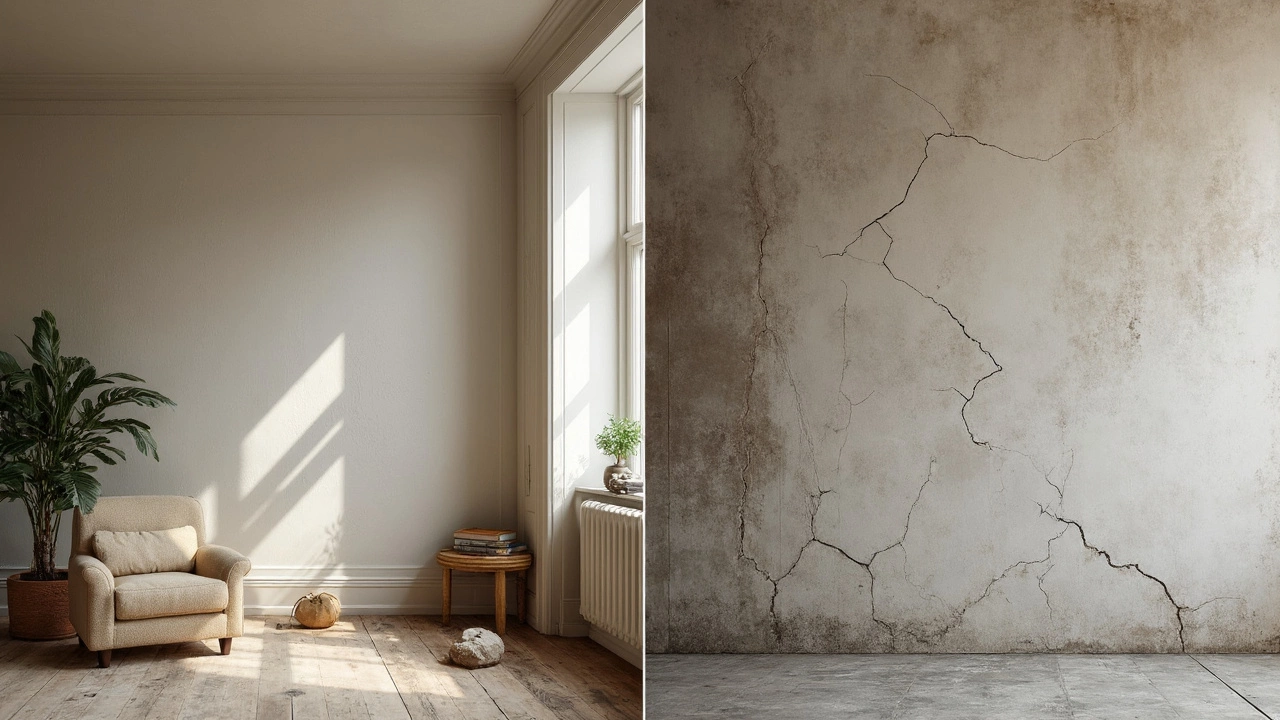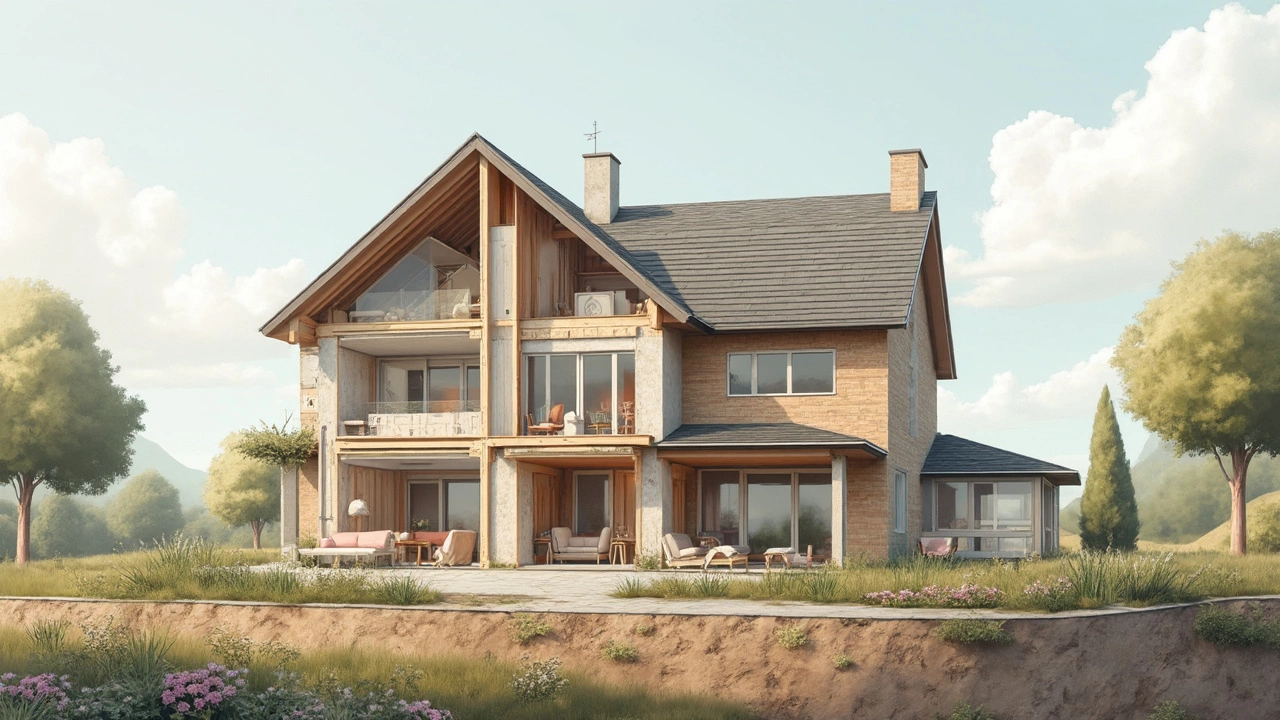Ever walked into a brand-new house and noticed a tiny crack here or there? It's more common than you might think. This doesn't necessarily mean the builders have failed you, though. New buildings go through a settling process—that's when the materials adjust to the climate and weight distribution changes. It's all part of the game!
But what exactly causes these cracks? Well, there are a few culprits. Changes in temperature and humidity can make newly laid materials expand and contract, which doesn't always line up perfectly. Not to mention, that fresh concrete needs time to dry out completely.
So, should you be worried? That's a bit of a tricky question. Tiny hairline cracks are often just cosmetic issues. They're common and generally not a cause for alarm. But if you notice a crack that seems to be growing or ones that run diagonally through the walls, it might be time to call in an expert to have a closer look.
- Understanding the Nature of Cracks
- Why Do New Builds Develop Cracks?
- When Should You Worry?
- Preventing and Fixing Cracks
- Tips for Maintaining New Builds
Understanding the Nature of Cracks
So, what's up with these cracks in new builds? Let's break it down. Cracks in buildings can occur for a bunch of reasons, and it’s not always as dramatic as it sounds. When you move into your brand-new house, the first thing to realize is that materials like wood, drywall, and concrete aren't static. They all respond to changes around them.
Types of Cracks
For starters, you have hairline cracks. These are usually super fine, almost like a pencil line. Often, they appear in places like ceilings and walls. Then, there are settlement cracks. These typically show up around doors or windows and sometimes might be a touch more noticeable.
Now, if you come across a wider crack, things might get more serious. Structural cracks are often wider than hairline ones and can look like jagged lightning bolts. These may affect the load-bearing capacity and require attention.
Factors Contributing to Cracks
Lots of factors come into play here. Think of the changing seasons; when it's humid, materials might swell, while in drier times, they could shrink. Another biggie is the settling of the building itself. Picture your house easing into its soil like settling into a favorite armchair.
Moisture and Humidity
Let’s talk moisture. If the soil under your house is constantly wet, it might expand, and when it dries, it contracts. This expansion and contraction can lead to low-level movement, causing cracks.
And don't forget about temperatures. They're like the unsung heroes (or villains) of crack formation. Your house settling is also part of this puzzle. New homes can spend years adjusting to their foundation, especially if the soil wasn’t compacted properly during construction.
Analyzing the Impact
How big of a deal are these cracks? Well, a good way to gauge is by measuring their width. Anything under a millimeter in width is usually not a big concern.
| Crack Type | Width | Concern Level |
|---|---|---|
| Hairline | < 1mm | Low |
| Settlement | 1-3mm | Moderate |
| Structural | > 3mm | High |
Remember, though, if a crack changes significantly in size or shape, it’s a smart move to get a professional opinion.
In other words, not all cracks are created equal. Keep an eye on them and know when it’s time to act. It’s like maintaining your car—regular check-ups can save a lot of hassle down the road.
Why Do New Builds Develop Cracks?
You're sitting in your brand-new home, and suddenly, there's a crack in the wall. The first question that pops into your head is probably, why? Well, new builds often develop cracks, and there are a few reasons why this happens.
Settling of the House
When builders finish construction, the structure isn't exactly in its permanent resting position. As it settles, the materials used to build your new place can shift a little. This settling process can lead to the formation of cracks. It's much like when you sit in a new chair for a while—it starts adjusting to your shape.
Changes in Temperature and Moisture
Cracks can also develop because of external factors like weather conditions. Changes in temperature and humidity can cause building materials to expand and contract. The new materials are quite sensitive and take time to fully adapt to their surrounding climate.
Use of Different Building Materials
Modern homes use a combination of various materials like wood, concrete, and drywall. Each of these materials reacts differently to environmental changes. Wood might expand, while concrete contracts, making it tough for them to work in harmony all the time.
"A small crack may not affect the structure's integrity, but tracking them is crucial," says Randy Jones, a well-known structural engineer.
Is It the Builder's Fault?
Now, you might wonder if it's something the builder did wrong. Not really. Cracks are often a natural part of the construction process. Builders even account for this when they design new homes, leaving space for potential expansion and contraction of materials.
Statistics on Cracks in New Builds
Believe it or not, about 70% of new homes develop some form of cracking within the first two years. Most of these are minor, non-structural cracks that can be easily repaired.
The key here is to differentiate if these cracks are just cosmetic or a sign of a more serious issue. If you're ever in doubt, always consult a professional for peace of mind.

When Should You Worry?
If you're noticing cracks in your new builds, it might leave you feeling a bit anxious. But don't hit the panic button just yet. Understanding when to really worry can save you unnecessary stress and money.
Recognizing Problematic Cracks
Not all cracks are created equal. Hairline fractures are usually harmless. However, there's a few red flags to watch out for:
- Width Matters: If a crack is wider than a quarter of an inch, it might mean trouble is brewing.
- Direction Counts: Diagonal cracks or those moving in a stepping pattern could suggest structural issues.
- Persistance is Key: If you keep patching a crack but it reappears or grows, it might be a symptom of a bigger problem.
Understanding Underlying Causes
Some cracks tie back to material drying, which is common, but others? Not so much. Soil movement under the house can lead to structural stress. If the builders didn't fully compact the soil or prep it right, that's trouble waiting to happen.
Unexpected water damage is another culprit. Leaking pipes or poor drainage can erode the soil and affect the foundation. It might not be obvious at first, but it can lead to those nasty cracks.
Next Steps If You're Concerned
Called a professional yet? It's a good idea if those cracks match the red flags. A structural engineer can assess the gravity of the matter and suggest a suitable fix.
Looking for a peace of mind? Keep an eye on things. Take photos and measure cracks, tracking any changes over time. This helps the professionals understand the issue's progress.
Here's a little snapshot to help you:
| Crack Width | Action Required |
|---|---|
| Less than 1/8 inch | Observe |
| 1/8 - 1/4 inch | Monitor and document |
| More than 1/4 inch | Consult an expert |
Preventing and Fixing Cracks
Cracks in new builds might seem inevitable, but there are ways to minimize them. It all starts with good construction practices. Builders should ensure proper foundation work, as this forms the base of everything. Solid ground with good drainage prevents unnecessary movement that might stress the building structure.
Construction and Material Tips
First off, choose quality materials. This might sound like a no-brainer, but it makes a difference. Materials that expand and contract consistently help reduce construction cracks. Good builders also incorporate expansion joints in concrete to accommodate movement without cracking.
Temperature matters too. Concrete and plaster are best applied when temperatures are mild. Extreme heat or cold during application can later lead to issues as they cure.
Regular Maintenance
Once you’ve got your new build, maintenance is your friend. Keep an eye out for small cracks and seal them up before they stretch further. A cheap tube of sealant now can save you from massive repair bills down the line.
Also, control moisture levels. Too much moisture might cause materials to swell, while too little could make them shrink. Using a dehumidifier or humidifier as needed can help maintain a balanced environment.
When to Bring in the Experts
If you spot a crack wider than a credit card or notice it growing quickly, it might be time for professional help. Structural concerns aren't a DIY project. Experts have the tools to assess and provide solutions that will ensure your home is safe and sound.
Quick Fixes
For minor cosmetic cracks, a bit of spackle and a fresh coat of paint often do the trick. Here's a simple guide:
- Clean the crack area with a brush or vacuum to remove dust and debris.
- Apply spackle or filler using a putty knife, smoothing it out evenly.
- Let it dry fully. Depending on the product, this could be a couple of hours.
- Sand it down until smooth. Don’t over-sand; just enough to blend with the wall.
- Paint over the area, matching your wall color.
Taking these steps means you'll keep those pesky cracks in check, maintaining both the beauty and structure of your new build.

Tips for Maintaining New Builds
Keeping your new builds in tip-top shape doesn't have to be a monumental task. With a bit of know-how and a few regular checks, you can ensure your modern abode stays solid and safe for years.
Regular Inspections Matter
The first rule of maintenance? Don’t wait for something to break. Regular inspections can spot small issues before they become serious. Check the walls, floors, and ceiling for any new cracks. Old boilers and appliance systems should make your list too. It might sound like a pain, but catching a problem early can save a world of headaches later.
Keep an Eye on Moisture Levels
In new homes, materials need some time to settle in. During this period, controlling humidity is vital. Excess moisture can lead to mold or even warp woodwork. Invest in a good humidifier or dehumidifier depending on the season. Your goal is to keep humidity levels between 30-50%.
Maintain Temperature Consistency
Temperature swings aren't just tough on humans—they’re hard on houses too. Try to keep your home within a stable temperature range. Sudden changes can lead to expansion and contraction, and voila, there's another construction crack.
Address Cracks Promptly
If you do see a crack, don’t panic. Not all cracks spell disaster. However, if you see a new one or notice changes in existing ones, especially if they’re widening, it's time to get them checked out. A professional can tell you if it's just a cosmetic flaw or something more serious.
Invest in Quality Materials and Professionals
When it comes to repairs or upgrades, skimping on materials or labor isn't the place to save a buck. Quality materials and skilled professionals make all the difference in preventing future problems.
These simple steps can help keep your new builds in prime condition, and most of them can be done with minimal hassle. When in doubt, always reach out to a professional for guidance.

Author
Damon Blackwood
I'm a seasoned consultant in the services industry, focusing primarily on project management and operational efficiency. I have a passion for writing about construction trends, exploring innovative techniques, and the impact of technology on traditional building practices. My work involves collaborating with construction firms to optimize their operations, ensuring they meet the industry's evolving demands. Through my writing, I aim to educate and inspire professionals in the construction field, sharing valuable insights and practical advice to enhance their projects.